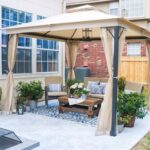Creating a sandbox for your outdoor play area is a great way to provide a fun and safe space for your children to play in the backyard.
You can choose a spot, build the sandbox, and add some toys to make it a perfect play area for your kids.
It’s a simple DIY project that can turn a regular sandbox into a fun adventure zone for your little ones.
Key Takeaways
- Choose a safe spot for the sandbox
- Use landscape fabric for stability and drainage
- Fill with play sand evenly
- Outline with rocks for safety
- Keep it clean with fresh sand
Sandbox Location and Sizing
When setting up your DIY sandbox, choose a visible and safe spot in your backyard. Make sure there’s enough space for kids to play comfortably. A typical sandbox size is 4’x4′ or 6’x6′, but adjust based on your available space. Pick a location that’s easily seen from your home so you can watch the kids.
Ensure the area is clear of obstacles and hazards. Keep it away from trees to avoid leaves and debris. If you plan on using wet sand, place the sandbox close to a water source.
Digging the Sandbox Hole
To make a sandbox, first, mark the size and shape you want in your yard. Dig a hole about 6–8 inches deep using a shovel. Make sure the bottom is flat and smooth. Check the depth and size as you go to match your plan.
To keep the sand clean and stop weeds, put down landscape fabric or a weed barrier at the bottom. This will help maintain the sandbox and keep out unwanted plants.
Doing these steps will create a sturdy base for your DIY sandbox, making it a fun and safe play area for kids.
Lining With Landscape Fabric
Landscape fabric is a good idea for your sandbox because it stops weeds, keeps the sand clean, makes it stable, and helps with drainage.
It stops weeds from growing, keeps the sand tidy, and provides a strong base for play.
It also helps water drain properly, so your sandbox stays in good shape.
Adding Sand to the Sandbox
When filling your sandbox with sand, make sure to choose good-quality sand for safe play.
Fill the sandbox evenly with the right amount of sand and smooth out the surface for a fun play area.
Sand Quality Matters
Choose child-friendly play sand that’s safe for kids and doesn’t contain harmful substances like silica or asbestos for your sandbox. Here’s what to look for:
- Pick-washed, natural sand without any dirt or bad stuff in it.
- Make sure the sand is safe for kids’ skin and won’t cause any harm.
- Get sand specifically made for playing in a sandbox.
- Figure out how much sand you need based on how big your sandbox is—usually around 40–50 pounds per square foot for a 6-inch-deep layer.
Filling the Sandbox
Add child-friendly play sand to your sandbox for a safe and fun play area. Buy special play sand bags for the sandbox.
Calculate how much sand you need based on the sandbox’s size and how deep you want it. Spread the sand evenly for a smooth surface. Layering the sand helps with drainage.
Keep the sandbox filled with fresh sand to maintain the right depth and cleanliness. Follow these steps to create a great outdoor play space for your kids.
Leveling the Surface
Smooth out the landscape fabric in the sandbox before pouring play sand evenly across the surface.
Use a rake to spread the sand, getting rid of any clumps or bumps.
Make sure the sand depth is around 10–12 inches for safe play.
Check and top up the sandbox regularly to keep it clean and at the right depth for your kids to enjoy.
Finishing With Rocks
When you’re done setting up your sandbox with rocks, remember to:
- Place the rocks strategically to outline the border and keep the sand in place.
- Pick rocks that match your yard.
- Make sure the rocks are secure to prevent accidents while playing.
Rock Placement Tips
For a neat and functional finish to your DIY sandbox project, consider placing rocks around the edge. Here are some tips for rock placement:
- Use rocks of different sizes and shapes for an interesting border.
- Rocks can be used as seats or climbing elements for kids to enjoy.
- Smooth, rounded rocks can give a natural touch to the sandbox.
- Make sure to embed rocks securely to prevent shifting and reduce tripping hazards.
Choosing the Right Rocks
When picking rocks for your sandbox, choose smooth, rounded rocks without sharp edges to keep kids safe. Make sure the rocks are durable enough to withstand play and the weather.
Pick rocks that look good with your outdoor space or add some color to the sandbox. The right rocks can make your sandbox both safe and stylish.
Safety Considerations for Rocks
When you use rocks in your sandbox, make sure they’re stable and safe. Choose smooth rocks to prevent injuries.
Place rocks securely to avoid tripping.
Always watch kids closely when they play in the sandbox to keep them safe.
Promoting Imaginative Play
Encouraging kids to play with DIY sandboxes can help boost their creativity and make outdoor play more fun. These sandboxes give children a space to use their imagination and tell creative stories. When kids pretend and act out different scenarios in the sandbox, they get better at solving problems and thinking creatively. Whether they’re building things or creating landscapes, the sandbox lets them bring their ideas to life.
Playing imaginatively not only keeps kids entertained but also helps them learn important skills like sharing and working together with others. When kids share their imaginative worlds with friends, they can play together, come up with stories, and be creative as a team. By playing together in the sandbox, kids practice communicating, compromising, and working towards common goals. This kind of play helps them feel like they belong and strengthens their friendships while having fun.
Encouraging Social Interaction
Encouraging social interaction in sandboxes helps kids develop important skills like communication, empathy, and cooperation. Sandboxes are great for group activities, where children can work together as a team and make new friends.
Kids learn how to resolve conflicts peacefully and improve their interpersonal skills while playing in a sandbox. Collaborative play in sandboxes, like storytelling and building projects, helps children work together, be creative, and have positive interactions.
Frequently Asked Questions
How Can I Make My Sandbox More Fun?
To make your sandbox more fun, you can add things like buried treasure, water features, movable parts, and natural elements. This will make it exciting and educational, giving you lots of ways to play and explore.
How to Make an Outdoor Sandbox?
Location: Anywhere with enough space
Materials: Sturdy wood frame, fabric, play sand
Activities: Sandcastle building, treasure hunting
Additional fun: Water play for sensory exploration
Features: Creative designs, natural elements
Should a Sandbox Have a Bottom?
Yes, a sandbox should have a bottom to keep it clean and prevent pests. You can use materials like landscaping fabric or plastic to stop weeds from growing and help with drainage. Make sure it’s installed properly for safety and to make maintenance easier.
What Is the Cheapest Way to Build a Sandbox?
To make a cheap sandbox, use old pallets and simple designs. Look for second-hand materials to save more money. Cover the box when not using it to keep maintenance easy.
Conclusion
To create a sandbox in your outdoor play area, you’ll need sand, rocks, and landscape fabric.
Follow these steps for a safe and fun space for kids to play in.
Get ready to see your little ones enjoy their own sandbox!











